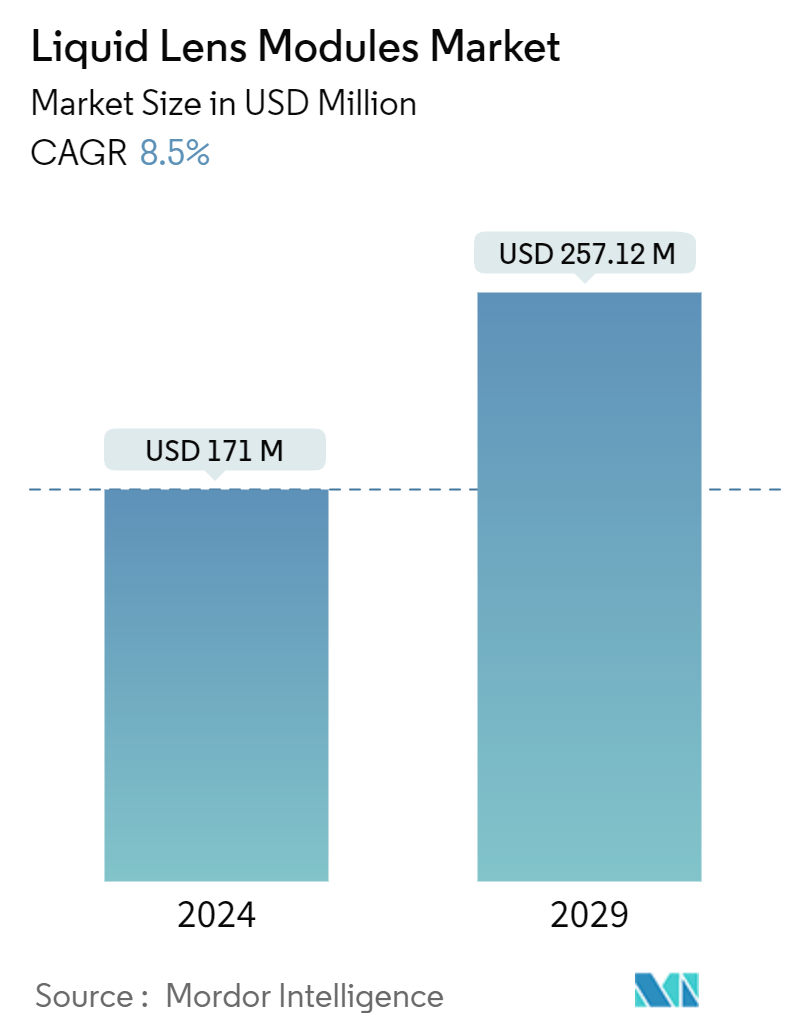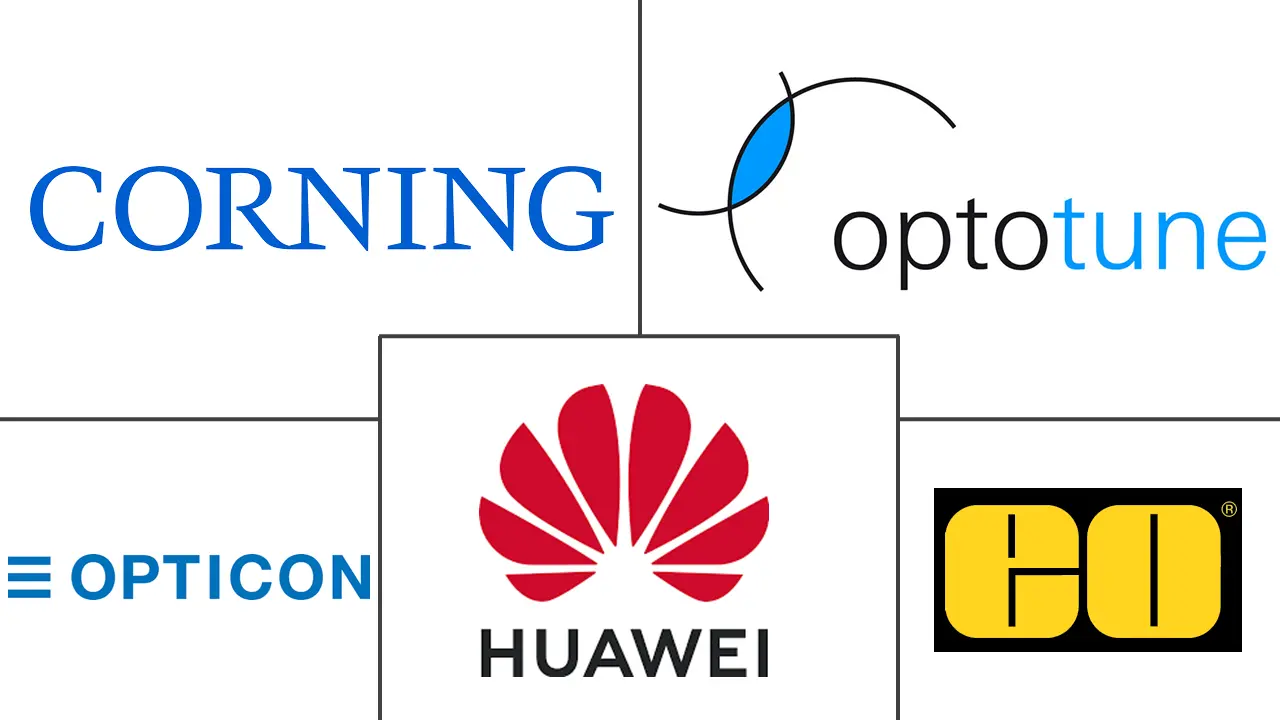Market Size of Liquid Lens Modules Industry

| Study Period | 2019 - 2029 |
| Market Size (2024) | USD 171 Million |
| Market Size (2029) | USD 257.12 Million |
| CAGR (2024 - 2029) | 8.50 % |
| Fastest Growing Market | Asia Pacific |
| Largest Market | North America |
Major Players
*Disclaimer: Major Players sorted in no particular order |
Liquid Lens Modules Market Analysis
The Liquid Lens Modules Market size is estimated at USD 171 million in 2024, and is expected to reach USD 257.12 million by 2029, growing at a CAGR of 8.5% during the forecast period (2024-2029).
Liquid lenses' speed, adaptability, and versatility make them suitable for several machine vision, life science, and measuring and inspection applications. When combined with a distance sensor and camera, a liquid lens may instantly image different planes of a 3D object. The photos are then stitched together in software to create an accurate three-dimensional depiction.
- Liquid lenses swiftly focus on accommodating objects at various WDs (working distances). Liquid lenses are small, mechanically, or electrically controlled cells comprising optical-grade liquid. The cell's shape changes when a current or voltage is applied to a liquid lens cell. This change happens within milliseconds and generates the optical power, and therefore focal length and WD, to shift. Several manufacturers have designed liquid lenses that operate through slightly different processes: electrowetting, current-driven polymer, or sound piezoelectric. Liquid lenses are suitable solutions for imaging applications requiring rapid focusing, high throughput, depth of field (DOF), and WD accommodation.
- Liquid lenses can be implemented in several locations throughout an imaging system, like being embedded within or threaded to the front or rear of an imaging lens. Fixed Focal Length and Zoom lenses usually rely on mechanical or manual adjustments to change focus, that can slow the imaging system. Liquid lens camera modules have very fast response times. A liquid lens eliminates mechanics, allowing for a more compact construction. Further, the functionality of liquid lenses is equivalent to that of several discrete lenses within an assembly. The total size and weight of the entire lens are reduced by eliminating those lenses and replacing them with a tiny liquid cell.
- The liquid lens modules are also useful for requiring rapid automated inspection like barcode reading, package sorting, and quality control. Another application where these small, variable-focus lenses are helpful is in AR applications/VR devices that need compact, lightweight, fast & low power consuming, silent lenses for zooming and focusing.
- Moreover, the rapid variable focus of a liquid lens can adjust dynamically as an airborne unit travels at various heights above the ground or distances from objects. They're especially useful in applications like geographic information/mapping systems, agricultural inspection & monitoring, and surveillance.
- However, liquid lens camera modules are a complex system involving a myriad of disciplines, technologies, and processes. The supply chain is witnessing complexities against the backdrop of overlaps between the activities of the modules' sub-component manufacturing companies. Challenges in realizing robust liquid lens module technology further add to the complexity of the ecosystem of the market, thereby creating challenges for the evolution of the technology. The high manufacturing costs are also anticipated to restrain the growth of the studied market during the forecast period.
- The COVID-19 pandemic increased the demand for contactless and minimally invasive forms of identification, which led to advancements in liquid lens technology for iris recognition. Liquid lens-enabled iris recognition systems offer an accurate and hygienic form of biometric identification, as they do not require physical contact between the user and the scanner. Additionally, liquid lenses possess a fast response time, as low as 10ms, enabling auto-focus and continuous focus for biometric applications. Outside of biometrics, liquid lenses also have the potential for applications in biomedical detection and micro-optic systems.
Liquid Lens Modules Industry Segmentation
A liquid lens is a camera technology that substitutes a static optical glass lens. It employs optical-grade liquid in the center of a cell structure and functions similarly to an eye lens. A liquid lens permits the lens to alter its form by means of adjusting the liquid inside it, which enhances focusing speed and focal length.
The liquid lens modules market is segmented by component (image sensor, lens, camera module assembly, VCM), application (camera, code reader, medical imaging), and geography (North America, Europe, Asia-Pacific, and the Rest of the World). The market sizes and forecasts are provided in terms of value (USD) for all the above segments.
| By Component | |
| Image Sensor | |
| Lens | |
| Camera Module Assembly | |
| VCM Suppliers |
| By Application | |
| Camera | |
| Code Reader | |
| Medical Imaging |
| By Geography | |
| North America | |
| Europe | |
| Asia | |
| Australia and New Zealand |
Liquid Lens Modules Market Size Summary
The liquid lens modules market is poised for significant growth, driven by their rapid focusing capabilities and versatility in various applications such as machine vision, life sciences, and inspection processes. These lenses, which utilize optical-grade liquids to adjust focal lengths swiftly, are increasingly favored for their compact design and ability to replace multiple discrete lenses, thereby reducing size and weight. The technology is particularly beneficial in fields requiring quick autofocus and high throughput, such as augmented reality, virtual reality, and automated inspection systems. Despite the complexities in manufacturing and high costs, the market is expected to expand as advancements continue to address these challenges.
North America is anticipated to hold a substantial share of the liquid lens modules market, supported by ongoing technological advancements and a robust presence of key industry players. The region's involvement in innovative projects, such as NASA's experiments with liquid lenses for space exploration, underscores the technology's potential across diverse sectors. The market's growth is further bolstered by the increasing demand for smartphones equipped with advanced camera technologies, which leverage liquid lens modules for superior image quality and optical zoom capabilities. Companies like Corning Incorporated and Xiaomi are at the forefront, investing in strategic developments to enhance their market position.
Liquid Lens Modules Market Size - Table of Contents
-
1. MARKET INSIGHTS
-
1.1 Market Overview
-
1.2 Industry Attractiveness - Porter's Five Forces Analysis
-
1.2.1 Bargaining Power of Suppliers
-
1.2.2 Bargaining Power of Buyers
-
1.2.3 Threat of New Entrants
-
1.2.4 Intensity of Competitive Rivalry
-
1.2.5 Threat of Substitutes
-
-
1.3 Technology Snapshot
-
1.4 Value Chain Analysis
-
1.5 Assessment of Impact of COVID-19 on the Market
-
-
2. MARKET SEGMENTATION
-
2.1 By Component
-
2.1.1 Image Sensor
-
2.1.2 Lens
-
2.1.3 Camera Module Assembly
-
2.1.4 VCM Suppliers
-
-
2.2 By Application
-
2.2.1 Camera
-
2.2.2 Code Reader
-
2.2.3 Medical Imaging
-
-
2.3 By Geography
-
2.3.1 North America
-
2.3.2 Europe
-
2.3.3 Asia
-
2.3.4 Australia and New Zealand
-
-
Liquid Lens Modules Market Size FAQs
How big is the Liquid Lens Modules Market?
The Liquid Lens Modules Market size is expected to reach USD 171 million in 2024 and grow at a CAGR of 8.5% to reach USD 257.12 million by 2029.
What is the current Liquid Lens Modules Market size?
In 2024, the Liquid Lens Modules Market size is expected to reach USD 171 million.

